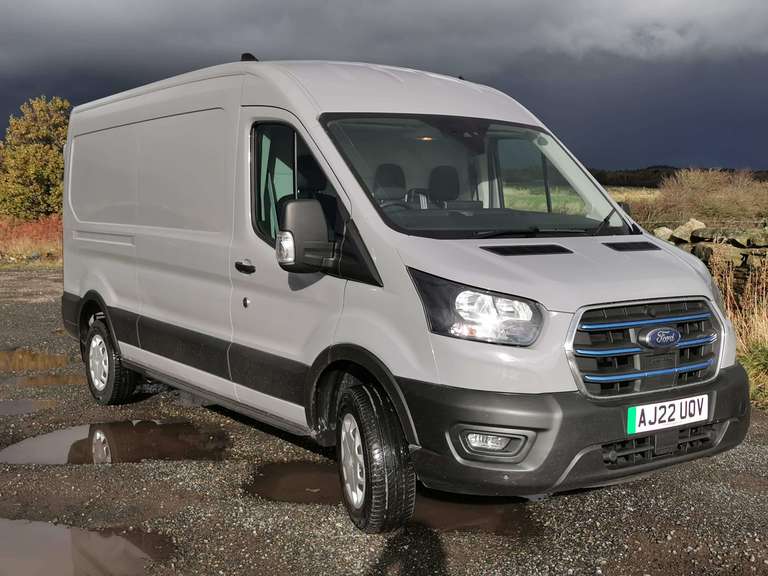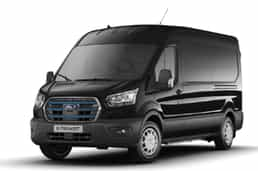Electric Vans / Electric Van Reviews / Ford E-Transit
There seemed to be a huge gap between Ford Pro announcing its entry to the electric van world to the vehicle being delivered to its first customers. But as you’d expect from the manufacturer of the UK’s best-selling vans the company made a huge effort to get the E-Transit right from the start. Our Van Expert Tim Cattlin gives us the low down on the large electric van from Ford…
To be fair to Ford, even though the E-Transit was a long time coming there hadn’t previously been too much activity from the competition in the large electric van sector. Some manufacturers such as Mercedes-Benz had dipped their toes in the water, but the products had a restricted range between charges, modest payloads, or both meaning that the sales achieved were relatively poor. The launch of the E-Transit with some pretty spectacular claims turned heads and set a new bar that any competitor needed to aim for.
Customers wanting to lease or buy a new electric van often have to make compromises when it comes to body derivatives in particular, availability being restricted compared to those in the diesel range. Not so with the E-Transit, the 25 combinations of length, height and weight being a close match, and the model range not being restricted to panel vans with double and chassis cabs being available from launch.



We’re all familiar with the shape of the Transit which has now been around for 10 years or so and Ford Pro had no reason to make major changes just to differentiate the E-Transit from its peers. It can however be identified by the three horizontal bars across the grill which are now coloured blue and badging on the rear door also makes a statement to those following in traffic that this is an electric version of the UK’s most popular large van.
The weight of the battery pack and electric drivetrain take their toll on any electric van, the E-Transit being no exception. On those vans with the typical GVM (Gross Vehicle Mass) of 3500kg, payloads range between 709kg and 1035kg, depending on the model.
Ford Pro has been quick to take up the UK government’s offer of a dispensation for electric vans, meaning that the GVM can be up to 4250kg and still driven by those holding a standard UK driving licence. There are some caveats to this which potential purchasers need to make themselves aware of but, this scheme means that the E-Transit has a maximum payload of 1758kgs.
Towing is restricted to the 3500kg GVM version, the trailer being restricted to a disappointing 750kg in weight. Internal dimensions are similar to those on the diesel van with the L2 providing 3083mm of load length, the L4 4256mm and load volumes range from 9.5 to 15.1 cubic metres. The load area is accessed by the usual twin rear and single side loading door, a full-height bulkhead protecting the driver and passengers from shifting loads.
Ford Pro has blessed the E-Transit with, on paper at least probably the best electric powertrain available on any large van. There’s a single battery option, a pack rated at 68kWh which is mounted underneath the van floor between a redesigned independent rear suspension layout.
This means that the battery location has no impact on the loading bay floor height. Driving the rear wheels, the motor is available in a choice of two power outputs, a more than adequate 184hp or, a what some might class as completely bonkers 269hp.The range available between charges is a major factor to consider for the electric van newcomer, and the E-Transit achieved a very commendable 196 miles on the official WLTP Combined test cycle.
It’s important to use these figures for comparison purposes only and all credit to Ford Pro for being transparent, suggesting that 100 miles should be achievable under even the very worst combination of operating conditions, such as a heavy load, cold, wet weather, challenging terrain and bad traffic.Connect the front grille mounted charge socket to an 11.3kW AC charger and you’ll go from a completely discharged battery pack to 100% of capacity in around 8.2 hours. The E-Transit can accept a DC charge rate of up to 115kW allowing for a 34-minute top-up from 15% to 80%.
E-Transit has a spacious cab which is almost identical to the standard Transit with high quality, robust materials being used throughout. Cab storage has been well thought out, the dash having various areas where items can be placed together with decent sized door bins and an overhead tray.
The dash is dominated by a 12” touchscreen which provides access to Ford’s SYNC4 system. Along with the usual phone and multimedia controls including smartphone integration, vehicle systems can be accessed along with Normal, Eco and Slippery driving modes, optimising range or traction as required. Unlike some competitor vehicles, mode selection is retained even after the vehicle has been switched off so if there’s a preference to use the van in Eco mode, the driver doesn’t have to remember to select it each time.
Preconditioning the temperature of the cab whilst the van is on charge (optimising range) is controlled either from the touchscreen or remotely from the FordPass Pro smartphone app. Even the battery can have its temperature optimised prior to the start of the journey, increasing efficiency.
The clear, uncluttered instrument panel displays the amount of charge remaining, both in percentage terms and also miles that can be covered. A dial shows the rate that power is being used, or that is being returned to the battery during regeneration when driving downhill or when the van is slowing down.
There are just two levels of trim on the E-Transit. Leader includes air conditioning, Ford’s legendary ‘Quickclear’ heated windscreen, heated seats and a dual passenger seat offering stowage and a fold-out table. Trend spec adds cruise control, front and rear parking sensors, safety tech such as lane keeping alert and pre-collision assist and a hand-stitched premium steering wheel.
A press of a ‘start’ button is accompanied by a few noises, indicating that the E-Transit is ready to go. The rotary drive selection control is located where the gear lever would normally be and once ‘D’ is selected, the van is off and running but with virtually no sound. My test van was the low-powered (!) 184hp version and, whilst gentle pressure on the accelerator led to drama-free driving, planting it to the floor gives stunning acceleration, the E-Transit hurtling forward at a more than impressive velocity. The 430Nm of torque, instantly available in full gives an experience that those who have spent their lives driving diesel vans will find game-changing.
Although the near silence offered by an electric drivetrain can often highlight other sources of noise, there is virtually no intrusion into the cab apart from a modest amount from the tyres depending on the road surface. This alone indicates the quality of build that Ford has put into the van.
My only gripe is the positioning of the SYNC4 screen. In a large van, a centrally mounted screen is always going to be a challenge for the driver to operate on the road but Ford Pro could have helped matters by angling it just a little toward the driver, something other manufacturers do. Presumably, designing a dash for a van that is going to be produced in left and right-hand drive form means that changes such as this could be costly, but it’s an irritation that could be easily removed.
The E-Transit has virtually all bases covered and even now, over 2 years since its launch other large van manufacturers are struggling to bring a van to market that can compete. Model choice, payload (on 4.25 GVM versions), power, range, it’s got the lot. It’s a truly excellent electric van.
 Ask for AvailabilityFord TransitE-Transit 350 L2H2 68kWh 184ps Trend
Ask for AvailabilityFord TransitE-Transit 350 L2H2 68kWh 184ps Trend
Go to deal
 Ask for AvailabilityFord TransitE-Transit 350 L3H2 68kWh 184ps Trend
Ask for AvailabilityFord TransitE-Transit 350 L3H2 68kWh 184ps Trend
Go to deal